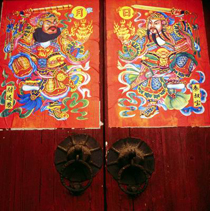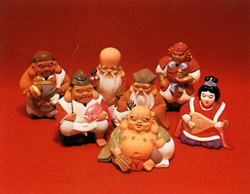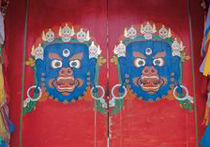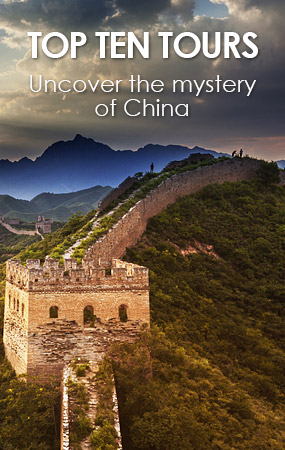Deities Worship
 As is reflected in Paper Joss, practitioners of the ancient trades enthusiastically sought to link themselves with historical figures who were considered the founders of their trades. For example, artisan-painters worshipped Wu Daozi, a great saint painter of the Tang Dynasty (9618-907) who began as an artisan-painter; carpenters and building workers venerated Lu Ban, a famous architect of the Lu State during the Spring and Autumn Period (770-476 B.C.); textile workers revered as their founder Huang Daopo, an outstanding woman technician in the textile industry during the Yuan Dynasty (1271-1368)...
As is reflected in Paper Joss, practitioners of the ancient trades enthusiastically sought to link themselves with historical figures who were considered the founders of their trades. For example, artisan-painters worshipped Wu Daozi, a great saint painter of the Tang Dynasty (9618-907) who began as an artisan-painter; carpenters and building workers venerated Lu Ban, a famous architect of the Lu State during the Spring and Autumn Period (770-476 B.C.); textile workers revered as their founder Huang Daopo, an outstanding woman technician in the textile industry during the Yuan Dynasty (1271-1368)...
The need for an honorary leader, an attractive spiritual idol that could unite all members of an organization and strengthen them for the long-term development of the industry, impelled ancient Chinese to worship historical figures, revering them as masters and founders. Worshipping historical idols not only reflects the people's feudal, superstitious ideas but also embodies the seeds of Chinese capitalism. It was an inevitable consequence in the course of Chinese social development.
As we promised earlier, here are some of the gods worshipped by ancient Chinese farmers. We will display other deities of all trades later by stages.
White-Horse Vanguard
 The White-Horse Vanguard was burned to "open a way " for god ascending to heaven or invite heavenly immortals to descend to this world during the sacrificials ceremony. Also, after a child had a shock and wasn't sleeping well, such a print would be burned in order to "recover the child's lost soul." The print is well executed with the image of a venerable old man on a galloping white horse. It is a traditional figure woodblock print with simple lines and fine cuts.
The White-Horse Vanguard was burned to "open a way " for god ascending to heaven or invite heavenly immortals to descend to this world during the sacrificials ceremony. Also, after a child had a shock and wasn't sleeping well, such a print would be burned in order to "recover the child's lost soul." The print is well executed with the image of a venerable old man on a galloping white horse. It is a traditional figure woodblock print with simple lines and fine cuts.
Legend has it that the god Shen Nong, surnamed Jiang, was an emperor in remote antiquity. He was also said to have taught the primitives how to make farming tools and grow crops, thus helping them evolve to an agricultural society from a fishing and hunting economy. He was believed to have tasted all the local herbs and become expert in the properties of herbal medicines. He taught people how to cure their diseases and collected his prescriptions in a book called the Materia Medica of Shen Nong. In addition, he advocated setting up regular markets on a barter basis. Later, he became the emperor Yan and reigned for 140 years.
Other farmers worshipped Tian Zu ,also called Hou Ji, as the God of Farmland. He was supposedly a high official in charge of agriculture during the reigns of the emperors Yao and Shun in remote antiquity. He also taught people how to grow crops. Later generations considered both Shen Nong and Tian Zu the founders of agriculture.
Ox King
The Ox King protected oxen and guarded them against diseases. In ancient China, the rural people offered sacrifices to the Ox King on the first day of the tenth lunar month. They used to celebrate the king's birthday on the twenty-fifth of the seventh lunar month, however, as the month was a busy season in farming. They later changed the date to the first of the tenth lunar month. This practice was followed until the end of the Qing Dynasty (1644-1911). It was said that the Duke Wen (765-716 B.C.) of the QinState once cut down a number of Chinese catalpa, which instantly changed to round them up. The duke sent his cavalrymen to round them up . The oxen ran into the river and disappeared. The shocked duke built a temple for the lost oxen, which was popularly known as the Ox KingTemple in later generations.
The Horse King
 The custom of offering sacrifices to the Horse King can be traced back to the Zhou Dynasty (11th century-256 B.C.). Local horse owners as well as cart drivers gathered on the twenty-third day of the sixth lunar month to celebrate the king's birthday. In old Beijing, people offered mutton instead of pork because the king was allegedly a muslim. The god was portrayed with four arms and three eyes; he was armored and awe-inspiring. Local military officers in ancient China also joined in the celebration.
The custom of offering sacrifices to the Horse King can be traced back to the Zhou Dynasty (11th century-256 B.C.). Local horse owners as well as cart drivers gathered on the twenty-third day of the sixth lunar month to celebrate the king's birthday. In old Beijing, people offered mutton instead of pork because the king was allegedly a muslim. The god was portrayed with four arms and three eyes; he was armored and awe-inspiring. Local military officers in ancient China also joined in the celebration.
Ox King and Horse King
In ancient China, rural people worshipped the Ox King and Horse King. They acknowledged the role oxen and horses had played in the development of agriculture and believed they shouldn't be forgotten. Here, the Ox King looks like a venerable scholar , corresponding to the ox's slow movement and endurance, whereas the Horse King appears as a masked military officer with four arms , symbolizing the horse's fiery disposition and quick movements. The suckling calf and newborn colt in the foreground signify the farmers' desire that the gods bless them with bumper harvests and healthy domestic animals.

